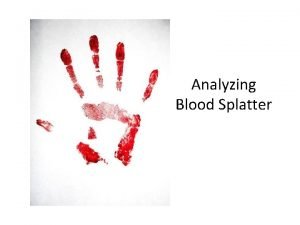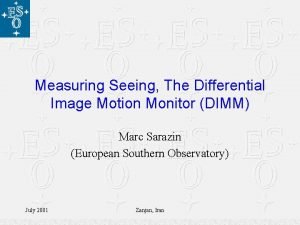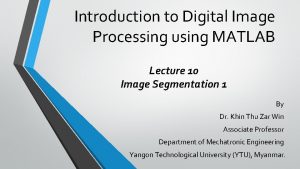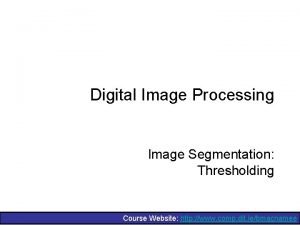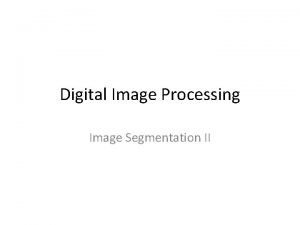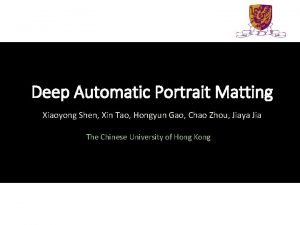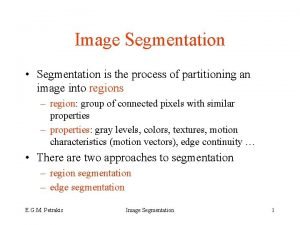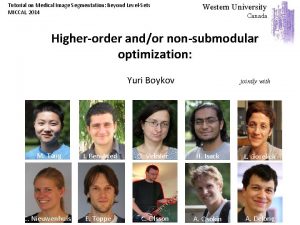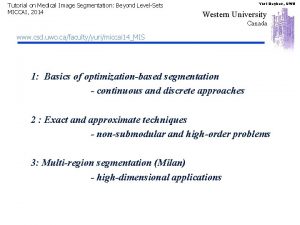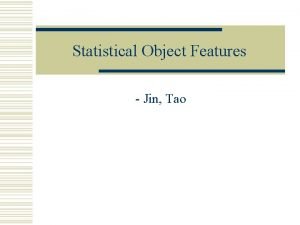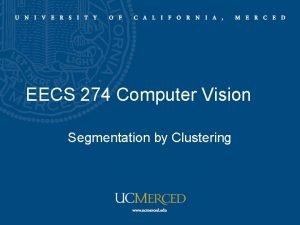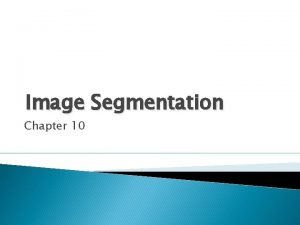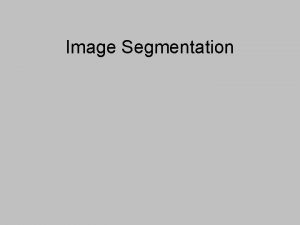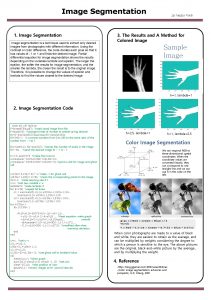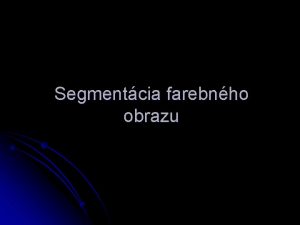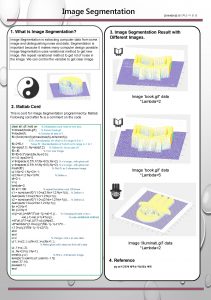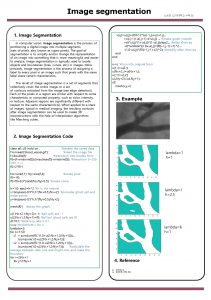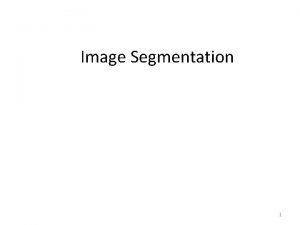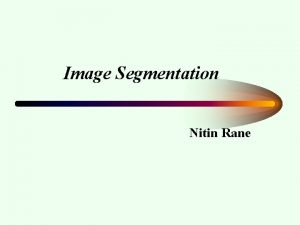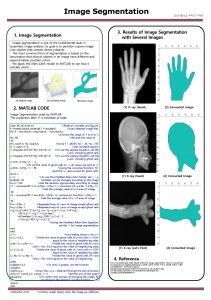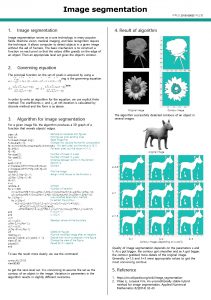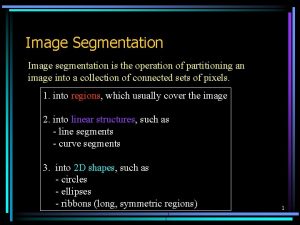Image Segmentation using Differential Evolution Michael Georgiopoulos Tiantian



![Applications of Image Segmentation q Medical Image Analysis Figure from [2]Tong Hau Lee, Mohammad Applications of Image Segmentation q Medical Image Analysis Figure from [2]Tong Hau Lee, Mohammad](https://slidetodoc.com/presentation_image/3adf54a262bddf8f4f6490a46e7f6cba/image-4.jpg)
![Applications of Image Segmentation q Remote Sensing Image Analysis Figure from [3] Patrik B. Applications of Image Segmentation q Remote Sensing Image Analysis Figure from [3] Patrik B.](https://slidetodoc.com/presentation_image/3adf54a262bddf8f4f6490a46e7f6cba/image-5.jpg)
![Applications of Image Segmentation q Document Analysis – Background removal Figure from [4] Benjamin Applications of Image Segmentation q Document Analysis – Background removal Figure from [4] Benjamin](https://slidetodoc.com/presentation_image/3adf54a262bddf8f4f6490a46e7f6cba/image-6.jpg)


![Proposed Project Work q The disadvantages of these algorithms are [6]: • The performance Proposed Project Work q The disadvantages of these algorithms are [6]: • The performance](https://slidetodoc.com/presentation_image/3adf54a262bddf8f4f6490a46e7f6cba/image-9.jpg)
![Proposed Project Work q Advantages of DE [7]: • Compared to most EAs, DE Proposed Project Work q Advantages of DE [7]: • Compared to most EAs, DE](https://slidetodoc.com/presentation_image/3adf54a262bddf8f4f6490a46e7f6cba/image-10.jpg)


![References [1] Jose Alfredo F. Costa and Jackson G. de Souza, “Image Segmentation through References [1] Jose Alfredo F. Costa and Jackson G. de Souza, “Image Segmentation through](https://slidetodoc.com/presentation_image/3adf54a262bddf8f4f6490a46e7f6cba/image-13.jpg)

- Slides: 14

Image Segmentation using Differential Evolution Michael Georgiopoulos Tiantian Zhang MACHINE LEARNING LAB

Mentor Information Faculty Mentor Info: Name: Michael Georgiopoulos Email: michaelg@ucf. edu Phone: 407 -312 -0957 Graduate Student Mentor Info: Name: Tiantian Zhang Email: watera 427@gmail. com Phone: 407 -284 -0799 MACHINE LEARNING LAB 2

Motivation q Image segmentation is based on non-supervised pattern classification techniques. In image segmentation, different features are extracted and grouped into different clusters, and thus the image is more visually preferable to reading useful information of differently grouped semantic regions. q Image segmentation has been widely used in various fields [1]. - Computer-aided diagnosis (CAD) for cancer detection, - Remote sensing image analysis, - Outdoor object recognition & robot vision, - Content-based image and marketplace decision support. [1] Jose Alfredo F. Costa and Jackson G. de Souza, “Image Segmentation through Clustering Based on Natural Computing Techniques”, pp. 57 -82, In: Image Segmentation, Pei-Gee Ho (Ed. ), 2011 MACHINE LEARNING LAB 3
![Applications of Image Segmentation q Medical Image Analysis Figure from 2Tong Hau Lee Mohammad Applications of Image Segmentation q Medical Image Analysis Figure from [2]Tong Hau Lee, Mohammad](https://slidetodoc.com/presentation_image/3adf54a262bddf8f4f6490a46e7f6cba/image-4.jpg)
Applications of Image Segmentation q Medical Image Analysis Figure from [2]Tong Hau Lee, Mohammad Faizal Ahmad Fauzi, Ryoichi Komiya, “Segmentation of CT Brain Images Using Unsupervised Clusterings”, Journal of Visualization, Vol. 12, No. 2 (2009) 131 -138 , 2009 MACHINE LEARNING LAB 4
![Applications of Image Segmentation q Remote Sensing Image Analysis Figure from 3 Patrik B Applications of Image Segmentation q Remote Sensing Image Analysis Figure from [3] Patrik B.](https://slidetodoc.com/presentation_image/3adf54a262bddf8f4f6490a46e7f6cba/image-5.jpg)
Applications of Image Segmentation q Remote Sensing Image Analysis Figure from [3] Patrik B. G. Dammert, Jan I. H. Askne, Sharon Kuhlmann, “Unsupervised Segmentation of Multitemporal Interferometric SAR Images”, IEEE Transactions on Geoscience and Remote Sensing, vol. 37, no. 5, Sep. 1999 MACHINE LEARNING LAB
![Applications of Image Segmentation q Document Analysis Background removal Figure from 4 Benjamin Applications of Image Segmentation q Document Analysis – Background removal Figure from [4] Benjamin](https://slidetodoc.com/presentation_image/3adf54a262bddf8f4f6490a46e7f6cba/image-6.jpg)
Applications of Image Segmentation q Document Analysis – Background removal Figure from [4] Benjamin Perret, Sébastien Lefèvre, Christophe Collet, and Éric Slezak, “Hyperconnections and Hierarchical Representations for Grayscale and Multiband Image Processing”, IEEE Transactions on Image Processing, Vol. 21, No. 1, January 2012 MACHINE LEARNING LAB

Applications of Image Segmentation q Sclera Recognition as human identification Matching Segmented Sclera Color Image Figure from [5] Segmented Sclera Region After Enhancement After Morphological Operations After Thresholding [5] Zhi Zhou, Eliza Yingzi Du, N. Luke Thomas, Edward J. Delp, “A New Human Identification Method: Sclera Recognition”, IEEE Transactions on Systems, Man, and Cybernetics—Part A: Systems and Humans, Vol. 42, No. 3, May 2012 MACHINE LEARNING LAB

Proposed Project Work q In this project, we are going to do Image Clustering using a variety of clustering approaches. q Typical clustering algorithms are: - K-means Algorithms - ISODATA Clustering Algorithms - Fuzzy C-Means (FCM) - Expectation-Maximization (EM) - K-harmonic Means (KHM) - Artificial Neural Networks (ANN) MACHINE LEARNING LAB
![Proposed Project Work q The disadvantages of these algorithms are 6 The performance Proposed Project Work q The disadvantages of these algorithms are [6]: • The performance](https://slidetodoc.com/presentation_image/3adf54a262bddf8f4f6490a46e7f6cba/image-9.jpg)
Proposed Project Work q The disadvantages of these algorithms are [6]: • The performance of some algorithms is highly dependent on initial conditions; • The number of clusters must be known a-priori information for some of algorithms; • Clustering is deemed to be a particular kind of NP-hard problem. Therefore, local search algorithms are inefficient sometimes. q Evolutionary Algorithms are designed to be population-based global search algorithms. They are metaheuristics widely believed to be effective on NP-hard problems, being able to provide near-optimal solutions to such problems in reasonable time [6]. q Differential Evolution is a simple and robust optimizer compared with other EAs. [6] Eduardo R. Hruschka, Ricardo J. G. B. Campello, Alex A. Freitas, André C. P. L. F. de Carvalho, “A Survey of Evolutionary Algorithms for Clustering”, IEEE Transactions on Systems, Man, and Cybernetics, 2012 MACHINE LEARNING LAB
![Proposed Project Work q Advantages of DE 7 Compared to most EAs DE Proposed Project Work q Advantages of DE [7]: • Compared to most EAs, DE](https://slidetodoc.com/presentation_image/3adf54a262bddf8f4f6490a46e7f6cba/image-10.jpg)
Proposed Project Work q Advantages of DE [7]: • Compared to most EAs, DE is much simpler and thus straightforward to implement. • Despite its simplicity, DE exhibits much better performance in comparison with several other EAs. - DE finished third in the First International Contest on Evolutionary Optimization in May 1996 (CEC, 1996). - DE turned out to be the best evolutionary algorithm for solving the real-valued test function suite of the 1 st ICEO - In the 2005 CEC competition on real time parameter optimization, on 10 -D problems classical DE secured 2 nd rank, while a self-adaptive DE variant called Sa. DE secured third rank. • The number of control parameters in DE are is very few (Cr, F and Np in classical DE q DE has been widely used in signal and image processing, pattern recognition, chemical engineering, electrical power system, and bioinformatics, etc. [7] Swagatam Das, Ponnuthurai Nagaratnam Suganthan, Differential Evolution: A Survey of the State-of-the-Art, IEEE Transactions on Evolutionary Computation, Vol. 15, pp. 4 -31, Feb. 2011. MACHINE LEARNING LAB

Proposed Work; Related Knowledge q Image Fundamentals: - Image Representation, Pixel Intensity, Color, Gray. Scale Images - Useful Image Transformations q Mathematical Knowledge: - Vectors and Operations on Vectors - Geometrical Representation of Vectors - Euclidean Distance calculation in multi dimensional space. q Programming Techniques: - Matlab Fundamentals - Image Processing Toolbox Functionality q Machine Learning Knowledge: - K-Means Clustering Algorithm - Differential Evolution and variant Algorithms MACHINE LEARNING LAB

Timeline for Proposed Work q Week 1: - How to use MATLAB q Week 2: - Fundamentals of Image Processing - Introduction to Clustering - K-means Algorithm and its implementation q Week 3: - K-means algorithm and image clustering applications - DE algorithm and its variants q Week 4: - DE implementation and optimization problem applications - ACDE algorithm q Week 5: - Implementation of ACDE and image clustering applications q Week 6: - Work on deliverables MACHINE LEARNING LAB
![References 1 Jose Alfredo F Costa and Jackson G de Souza Image Segmentation through References [1] Jose Alfredo F. Costa and Jackson G. de Souza, “Image Segmentation through](https://slidetodoc.com/presentation_image/3adf54a262bddf8f4f6490a46e7f6cba/image-13.jpg)
References [1] Jose Alfredo F. Costa and Jackson G. de Souza, “Image Segmentation through Clustering Based on Natural Computing Techniques”, pp. 57 -82, In: Image Segmentation, Pei-Gee Ho (Ed. ), 2011 [2]Tong Hau Lee, Mohammad Faizal Ahmad Fauzi, Ryoichi Komiya, “Segmentation of CT Brain Images Using Unsupervised Clusterings”, Journal of Visualization, Vol. 12, No. 2 (2009) 131 -138 , 2009 [3] Patrik B. G. Dammert, Jan I. H. Askne, Sharon Kuhlmann, “Unsupervised Segmentation of Multitemporal Interferometric SAR Images”, IEEE Transactions on Geoscience and Remote Sensing, vol. 37, no. 5, Sep. 1999 [4] Benjamin Perret, Sébastien Lefèvre, Christophe Collet, and Éric Slezak, “Hyperconnections and Hierarchical Representations for Grayscale and Multiband Image Processing”, IEEE Transactions on Image Processing, Vol. 21, No. 1, January 2012 [5] Zhi Zhou, Eliza Yingzi Du, N. Luke Thomas, Edward J. Delp, “A New Human Identification Method: Sclera Recognition”, IEEE Transactions on Systems, Man, and Cybernetics—Part A: Systems and Humans, Vol. 42, No. 3, May 2012 [6] Eduardo R. Hruschka, Ricardo J. G. B. Campello, Alex A. Freitas, André C. P. L. F. de Carvalho, “A Survey of Evolutionary Algorithms for Clustering”, IEEE Transactions on Systems, Man, and Cybernetics, 2012 [7] Swagatam Das, Ponnuthurai Nagaratnam Suganthan, Differential Evolution: A Survey of the State-of-the-Art, IEEE Transactions on Evolutionary Computation, Vol. 15, pp. 4 -31, Feb. 2011. MACHINE LEARNING LAB

Thank you! Any Questions? MACHINE LEARNING LAB 14
 Key stages in digital image processing
Key stages in digital image processing Area of convergence
Area of convergence Michael cheval evolution
Michael cheval evolution Differential image motion monitor
Differential image motion monitor Double thresholding matlab
Double thresholding matlab Introduction to digital image processing
Introduction to digital image processing Image processing
Image processing Filteration
Filteration Deep automatic portrait matting
Deep automatic portrait matting Image partitioning
Image partitioning Medical image segmentation tutorial
Medical image segmentation tutorial Boykov and jolly 2001
Boykov and jolly 2001 Image processing segmentation
Image processing segmentation Oliver van kaick
Oliver van kaick Image segmentation
Image segmentation

